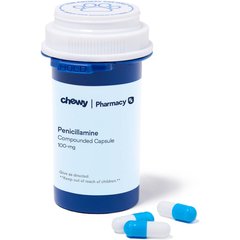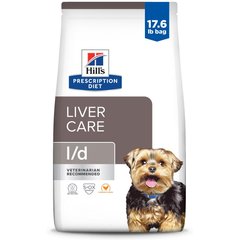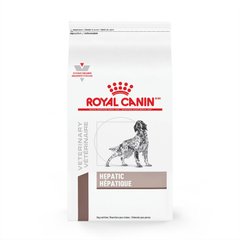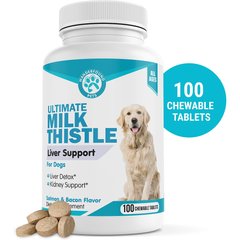Copper Storage Disease in Dogs
Evgenia Glinskaia/iStock / Getty Images Plus via Getty Images
What Is Copper Storage Disease in Dogs?
Copper is a mineral that is essential to your dog’s diet and overall health. It’s needed for absorption of iron, production of red blood cells, and maintenance of the nervous and immune systems. However, too much copper can have harmful effects on a dog’s body.
Copper is metabolized in the liver, where it’s either stored or sent to other parts of the body. Under normal circumstances, excess copper is broken down and eliminated. However, in some dogs, copper builds up in the liver and leads to copper-associated hepatopathy, also known as copper storage disease in dogs.
Copper-associated hepatopathy is a relatively common condition in dogs that leads to liver inflammation, which can progress to liver failure and death. Because excess copper can cause a dog’s immune system to destroy red blood cells, dogs with copper storage disease are also at risk for severe anemia.
Copper storage disease in dogs is a medical emergency. If your dog is showing symptoms, take them to the veterinarian immediately. Without appropriate diagnosis and treatment, symptoms will become more severe over time.
Symptoms of Copper Storage Disease in Dogs
Dogs typically don’t display symptoms of copper storage disease until the condition is advanced. Symptoms of copper storage disease in dogs include:
-
Pale gums (if anemia has developed)
Causes of Copper Storage Disease in Dogs
Copper storage disease in dogs is typically caused by an inherited genetic mutation that prevents the liver from eliminating excess copper from the body.
The excess copper accumulates in the dog’s liver, leading to significant inflammation, cellular damage, and symptoms.
Eating a diet with excessive copper is another possible cause. This may occur if a dog is fed foods that are known to be high in copper, such as beans, potatoes, and shellfish. This is most likely to occur when dogs are fed homemade diets without veterinary guidance.
Any breed can be affected by copper storage disease, but there are a few breeds more likely to develop the condition. These include:
How Veterinarians Diagnose Copper Storage Disease in Dogs
Veterinarians diagnose copper storage disease in dogs using a combination of clinical signs and diagnostic tests. Pet parents should provide their veterinarians with a thorough medical history—including when symptoms started—to aid in the diagnosis.
Additionally, if a pet parent got their pup from a breeder, medical records can help identify dogs who may be at risk for the disease based on their breed and family history.
Because it can take a while for symptoms to develop and most of them are seen in several other conditions, veterinarians will use additional tests to confirm a diagnosis of copper storage disease. These tests may include:
-
Blood work—A blood sample to check a dog’s overall health and identify liver abnormalities.
-
DNA testing—This can determine whether a dog is a carrier of the genetic mutation that causes copper storage disease.
-
Liver biopsy—A veterinarian uses a needle to collect a sample directly from the liver while the dog is sedated or anesthetized. The samples are sent to a lab to identify excess copper. This is the only test that provides a definitive diagnosis of copper storage disease.
Treatment of Copper Storage Disease in Dogs
Dogs with copper storage disease require lifelong management. Potential treatment options include:
-
D-penicillamine—This medication is the preferred method of treatment. It binds excess copper in a dog’s body so it can be excreted in the urine. It can take months or even years to remove all of the accumulated copper by using this medication.
-
Low-copper diet—Dogs who have been diagnosed with copper storage disease should be switched to a diet that is low in copper, such as Hill's® Science Diet l/d Liver Care or Royal Canin® Hepatic Veterinary Diet. Dogs with copper storage disease who are not genetically predisposed and who have developed the condition due to excess dietary copper also benefit from this option.
-
Zinc—This supplement prevents copper absorption. While zinc supplementation is not the preferred treatment option, it may be beneficial in some cases.
Recovery and Management of Copper Storage Disease in Dogs
Copper storage disease is a condition that requires lifelong treatment. Even with treatment, copper will continue to accumulate in the liver of dogs with an underlying genetic mutation. The goal of treatment is to reduce the amount of copper accumulation and support liver health.
Supplements that may help dogs with copper storage disease include:
-
S-adenosyl methionine (SAMe)—This supplement is an antioxidant that supports healthy liver function.
-
Milk thistle—This supplement helps reduce inflammation and prevent liver damage.
-
Ursodiol—This bile acid is an antioxidant that helps reduce liver inflammation.
Because copper storage disease is not typically diagnosed until the condition becomes severe, it’s difficult to fully remove all the excess copper from a dog’s liver. The prognosis is best when treatment is started early.
Prevention of Copper Storage Disease in Dogs
Because this disease is due to an inherited genetic mutation, it’s impossible to fully prevent it in predisposed dogs. However, for at-risk breeds, a liver biopsy can be performed at a young age to identify concerning changes.
In these cases, treatment options such as a low-copper diet can be started early to prevent severe disease from developing. Additionally, known carriers of the mutation should not be bred.
Copper Storage Disease in Dogs FAQs
What is the life expectancy of a dog with copper storage disease?
Dogs with copper storage disease on average survive about 18 months after diagnosis. This is highly variable and depends on the disease’s severity at the time of diagnosis. The more advanced the condition is when it is diagnosed, the shorter the dog’s expected lifespan.





